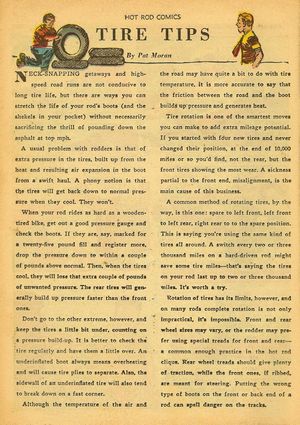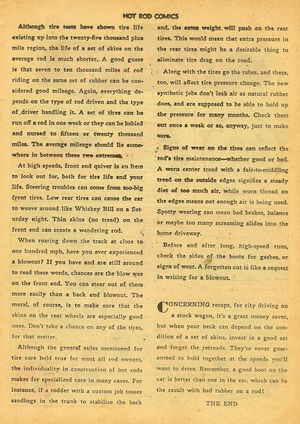|
By accessing or using The Crittenden Automotive Library™/CarsAndRacingStuff.com, you signify your agreement with the Terms of Use on our Legal Information page. Our Privacy Policy is also available there. |

Tire Tips
|
|---|
|
|
Tire Tips
Pat Moran
Hot Rod Comics #7
February 1953
Neck-snapping getaways and high-speed road runs are not conducive to long tire life, but there are ways you can stretch the life of your rod's boots (and the shekels in your pocket) without necessarily sacrificing the thrill of pounding down the asphalt at top mph.
A usual problem with rodders is that of extra pressure in the tires, built up from the heat and resulting air expansion in the boot from a swift haul. A phony notion is that the tires will get back down to normal pressure when they cool. They won't.
When your rod rides as hard as a wooden-tired bike, get out a good pressure gauge and check the boots. If they are, say, marked for a twenty-five pound fill and register more, drop the pressure down to within a couple of pounds above normal. Then, when the tires cool, they will lose that extra couple of pounds of unwanted pressure. The rear tires will generally build up pressure faster than the front ones.
Don't go to the other extreme, however, and keep the tires a little bit under, counting on a pressure build-up. It is better to check the tire regularly and have them a little bit over. An underinflated boot always means overheating and will cause tire plies to separate. Also, the sidewall of an underinflated tire will also tend to break down on a fast corner.
Although the temperature of the air and the road may have quite a bit to do with tire temperature, it is more accurate to say that the friction between the road and the boot builds up pressure and generates heat.
Tire rotation is one of the smartest moves you can make to add extra mileage potential. If you started with four new tires and never changed their position, at the end of 10,000 miles or so you'd find, not the rear, but the front tires showing the most wear. A sickness partial to the front end, misalignment, is the main cause of this business.
A common method of rotating tires, by the way, is this one: spare to left front, left front to left rear, right rear to the spare position. This is saying you're using the same kind of tires all around. A switch every two or three thousand miles on a hard driven rod might save some tire miles—that's saying the tires on your rod last up to two or three thousand miles. It's worth a try.
Rotation of tires has its limits, however, and on many rods complete rotation is not only impractical, it's impossible. Front and rear wheel sizes may vary, or the rodder may prefer using special treads for front and rear—a common enough practice in the hot rod clique. Rear wheel treads should give plenty of traction, while the front ones, if ribbed, are meant for steering. Putting the wrong type of boots on the front or back end of a rod can spell danger on the tracks.
Although tire tests have shown tire life existing up into the twenty-five thousand plus mile region, the life of a set of skins on the average rod is much shorter. A good guess is that seven to ten thousand miles of rod riding on the same set of rubber tires can be considered good mileage. Again, everything depends on the type of rod driven and the type of driver handling it. A set of tires can be run off a rod in one week or they can be babied and nursed to fifteen or twenty thousand miles. The average mileage should lie somewhere in between these two extremes.
At high speeds, front end quiver is an item to look out for, both for tire life and your life. Steering troubles can come from too-big front tires. Low rear tires can cause the car to weave around like Whiskey Bill on a Saturday night. Thin skins (no tread) on the front end can create a wandering rod.
When roaring down the track at close to one hundred mph, have you ever experienced a blowout? If you have and are still around to read these words, chances are the blow was on the front end. You can steer out of them more easily than a back end blowout. The moral, of course, is to make sure that the skins on the rear wheels are especially good ones. Don't take a chance on any of the tires, for that matter.
Although the general rules mentioned for tire care hold true for most all rod owners, the individuality in construction of hot rods makes for specialized care in many cases. For instance, if a rodder with a custom job tosses sandbags in the trunk to stabilize the back end, the extra weight will push on the rear tires. This would mean that extra pressure in the rear tires might be a desirable thing to eliminate tire drag on the road.
Along with the tires go the tubes, and these, too, will affect tire pressure change. The new synthetic jobs don't leak air as natural rubber does, and are supposed to be able to hold up the pressure for many months. Check them out once a week or so, anyway, just to make sure.
Signs of wear on the tires can reflect the rod's tire maintenance—whether good or bad. A worn center tread with a fair-to-middling tread on the outside edges signifies a steady diet of too much air, while worn thread on the edges means not enough air is being used. Spotty wearing can mean bad brakes, balance or maybe too many screaming slides into the home driveway.
Before and after long, high-speed runs, check the sides of the boots for gashes, or signs of wear. A forgotten cut is like a request in writing for a blowout.
Concerning recaps, for city driving on a stock wagon, it's a great money saver, but when your neck can depend on the condition of a set of skins, invest in a good set and forget the retreads. They're never guaranteed to hold together at the speeds you'll want to drive. Remember, a good boot on the car is better than one in the car, which can be the result with bad rubber on a rod!
THE END
This article was reprinted without the byline and the last paragraph in Hot Rods and Racing Cars #22, May 1955



















